
Giorgio Vasari was an Italian painter, architect, engineer, writer, and historian, best known for his Lives of the Most Excellent Painters, Sculptors, and Architects, considered the ideological foundation of art-historical writing, and the basis for biographies of several Renaissance artists, including Leonardo da Vinci and Michelangelo. Vasari designed the Tomb of Michelangelo in the Basilica of Santa Croce, Florence that was completed in 1578. Based on Vasari's text in print about Giotto's new manner of painting as a rinascita (rebirth), author Jules Michelet in his Histoire de France (1835) suggested adoption of Vasari's concept, using the term Renaissance to distinguish the cultural change. The term was adopted thereafter in historiography and still is in use today.

The Sienese School of painting flourished in Siena, Italy, between the 13th and 15th centuries. Its most important artists include Duccio, whose work shows Byzantine influence, his pupil Simone Martini, the brothers Pietro and Ambrogio Lorenzetti and Domenico and Taddeo di Bartolo, Sassetta, and Matteo di Giovanni.

Simone Martini was an Italian painter born in Siena. He was a major figure in the development of early Italian painting and greatly influenced the development of the International Gothic style.

Lorenzo di Pietro, known as Vecchietta, was an Italian Sienese School painter, sculptor, goldsmith, and architect of the Renaissance. He is among the artists profiled in Vasari's Le Vite delle più eccellenti pittori, scultori, ed architettori.

Il Sodoma was the name given to the Italian Renaissance painter Giovanni Antonio Bazzi. Il Sodoma painted in a manner that superimposed the High Renaissance style of early 16th-century Rome onto the traditions of the provincial Sienese school; he spent the bulk of his professional life in Siena, with two periods in Rome.
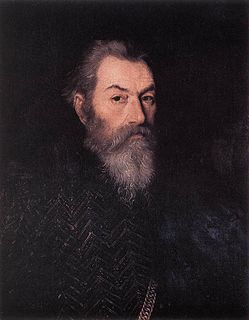
Paolo Farinati was an Italian painter of the Mannerist style, active in mainly in his native Verona, but also in Mantua and Venice.
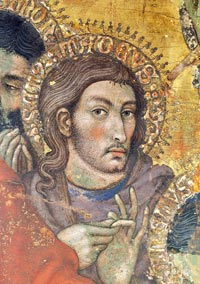
Taddeo di Bartolo, also known as Taddeo Bartoli, was an Italian painter of the Sienese School during the early Renaissance. He is among the artists profiled in Vasari's biographies of artists or Vite. Vasari claims he is the uncle of Domenico di Bartolo.

The Battle of Anghiari (1505) was a planned painting by Leonardo da Vinci, often referred to as "The Lost Leonardo". Its central scene would have depicted four men riding raging war horses engaged in a battle for possession of a standard at the Battle of Anghiari in 1440.

Giovanni Battista Zelotti was an Italian painter of the late Renaissance, active in Venice and her mainland territories.

Vincenzo Tamagni was an Italian painter of the Renaissance. Born in San Gimignano, he became an apprentice first with il Sodoma at Monte Oliveto Maggiore, and then worked in the Vatican Loggie under Raphael in Rome (1512-1516). Drawings of the Raphael frescoes in Tamagni's hand exist. He mainly painted in the towns surrounding Siena. He painted altarpieces for San Girolamo and Sant'Agostino in San Gimignano. He is featured in Giorgio Vasari's Vite, who refers to him as Vincenzo da San Gimignano.

The Lives of the Most Excellent Painters, Sculptors, and Architects, often simply known as The Lives, is a series of artist biographies written by 16th-century Italian painter and architect Giorgio Vasari, which is considered "perhaps the most famous, and even today the most-read work of the older literature of art", "some of the Italian Renaissance's most influential writing on art", and "the first important book on art history".
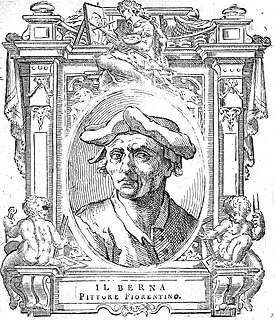
Barna da Siena, also known as Berna di Siena, was presumed to be a Sienese painter active from about 1330 to 1350.
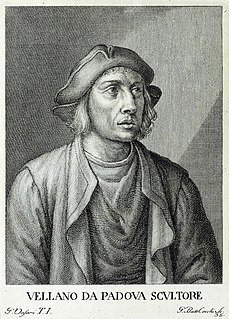
Bartolomeo Bellano, also known as Bartolomeo Vellano, was an Italian renaissance sculptor and architect who was born in Padua in 1437 or 1438. He was the son of a goldsmith and became a student of the sculptor Donatello, with whom he worked on many projects, including in the Basilica of Saint Anthony of Padua.

Bartolomeo della Gatta (1448–1502), born Pietro di Antonio Dei, was an Italian (Florentine) painter, illuminator, and architect. He was the son of a goldsmith. He was a colleague of Fra Bartolommeo. In 1468, Bartolomeo became a monk in the Order of Camaldoli, which his brother Nicolo had already entered. Upon taking holy orders, he changed his name to Bartolomeo. About 1481, he was summoned to Rome where he contributed to the cycle of frescos on the walls of the Sistine Chapel. He collaborated with Luca Signorelli. Bartolomeo eventually became abbot of the abbey of San Clemente in Arezzo. He died in 1502 and was buried in the abbey of San Clemente.
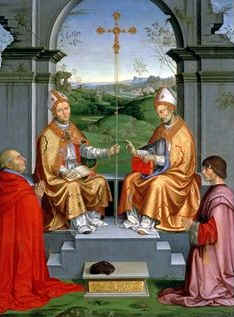
Timoteo Viti, sometimes called Timoteo della Viti or Timoteo da Urbino, was an Italian Renaissance painter, who was closely associated with Raphael, who was fourteen years his junior.

Gian Carlo Aliberti, also Giancarlo or Giovanni Carlo Aliberti, was a prolific Piedmontese painter of the seventeenth and eighteenth centuries.

Francesco Mancini was an Italian painter whose works are known between 1719 and 1756. He was the pupil of Carlo Cignani.

The Italian painter and engraver Bernardino Mei worked in a Baroque manner in his native Siena and in Rome, finding patronage above all in the Chigi family.

The Palazzo Torfanini is a Renaissance architecture palace located on Via Galliera 4, in central Bologna. It is located near the Palazzo Aldrovandi. The palace, with typical facade arcades, was commissioned by Bartolomeo Torfanini in 1544.

The Palazzo Celsi Pollini, once also called the Palazzo del Vescovo, is a Renaissance style urban palace in Siena, Italy. It is located on Pian dei Mantellini #39-41, at the corner with Via San Quirico. A 19th-century source refers to the house as Casa Campioni. The main facade faces the campanile of San Niccolò del Carmine.



















